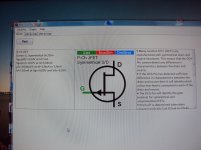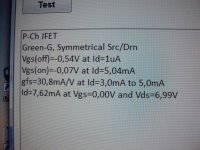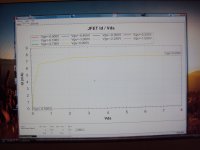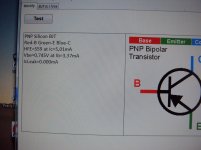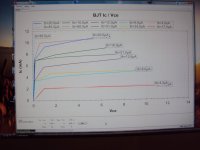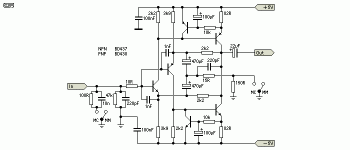Actually the avalanche noise in BJTs is very similar to what happens in a zener diode.
Something like 6V Vce is optimal i think.http://www.electronics.dit.ie/staff/ypanarin/Lecture Notes/DT021-4/3NoiseAnalysis.pdf
Something like 6V Vce is optimal i think.http://www.electronics.dit.ie/staff/ypanarin/Lecture Notes/DT021-4/3NoiseAnalysis.pdf
When more dynamic range is needed in an MC head i would then go for cascoding.
Anyway, in the Paradise we use more then 6V on the input transistors without cascode and the noise is reported to be very low. Maybe i am a bit neurotic and too careful to avoid noise.
It is a revelation though to listen to an ultra low noise phono stage although the mechanical noise is much higher. This is a bit like listening to a low distortion amp over a higher distortion speaker. Mechanical and electrical noise and distortion do not have the same origin and the ear can differentiate this i think.
Anyway, in the Paradise we use more then 6V on the input transistors without cascode and the noise is reported to be very low. Maybe i am a bit neurotic and too careful to avoid noise.
It is a revelation though to listen to an ultra low noise phono stage although the mechanical noise is much higher. This is a bit like listening to a low distortion amp over a higher distortion speaker. Mechanical and electrical noise and distortion do not have the same origin and the ear can differentiate this i think.
Its like when magnifying a dirty object. If the lens is good the object still has dirt but you know what dirt and where.😀It is a revelation though to listen to an ultra low noise phono stage although the mechanical noise is much higher.
Somehow my system can put the dirt into other places in the 3 dimensional image where it does not disturb much and the music comes through non the less.
Scratches sound really "short" and occupy only a small space.
A good record cleaning machine helps tremendous.
Some really worn records are hopeless though but choosing the program material is part of the art of vinyl.
Scratches sound really "short" and occupy only a small space.
A good record cleaning machine helps tremendous.
Some really worn records are hopeless though but choosing the program material is part of the art of vinyl.
Here you see what we call in German " Kennlinienfeld".
It shows that the Vce curve against idle gets flatter when the idle goes down.
My BC550C and BC560C samples did even better.
http://www.htl-rankweil.at/grass/ftkl/datenblatt_BC547.pdf
I noticed the same behaviour in fets... looking at k170 data, http://www.datasheetcatalog.org/datasheet/toshiba/1027.pdf , Id - Vds curve shows a flatter line for lower Id, but that means a lower Vgs (-0.4v) and looking at the Id - Vgs curve, we need higher Vgs (near -0.1v) to reach the most linear region.
IMO, in this case the solution is to compromise, use a Vds higher than 8 volts and a higher Vgs (-0.15v)
Here are some screen shots of the curve traces. The last graph shows the BC550C, 560C pair. Up to 2.5mA the curves are congruent.
Attachments
Few small high Hfe BJTs are going to prove great for symmetric without plenty of noisy degeneration or extensive paralleling with a Cob penalty I am afraid.
I am running this program on Bootcamp on my MAC so the Windows version is very basic.
I will look up if i find that tool nevertheless.
I have now measured BC327-40, 337-40 and also 1N4401, 4403.
The 337 is much faster then the PNP. The curves group only well under 2.5mA so the chosen idle for the Paradise is just about right. One advantgae of that trannies is the high Hfe giving relatively small base current. That helps with DC coupling of a common emitter stage like in the Paradise.
The 1N4401, 4403 combo is actually very good up to 4mA. The disadvantage i can see is less Hfe at a bit under 200.
Out of curiosity i measured BD139-16, 140-16 and they do very well up to 5mA.
I knew that from measurements that Sergio Santos made on the low distortion I/U converter.
I will look up if i find that tool nevertheless.
I have now measured BC327-40, 337-40 and also 1N4401, 4403.
The 337 is much faster then the PNP. The curves group only well under 2.5mA so the chosen idle for the Paradise is just about right. One advantgae of that trannies is the high Hfe giving relatively small base current. That helps with DC coupling of a common emitter stage like in the Paradise.
The 1N4401, 4403 combo is actually very good up to 4mA. The disadvantage i can see is less Hfe at a bit under 200.
Out of curiosity i measured BD139-16, 140-16 and they do very well up to 5mA.
I knew that from measurements that Sergio Santos made on the low distortion I/U converter.
Last edited:
The best pair i measured so far are the Sanyo 2SC3503, 2SA1381.
Very good up to 12mA, my measurement limit. They are also know for low Rbb`of under 20 Ohm. Sanyo are not making them any more but the Fairchild KSC replacements are reported to be as good. These are also great VAS driver and buffer trannis. Hfe is useful at a bit over 200.
I also tried the 2SC3601, 2SA1407 combo. They are famous for extremely low Rbb`of ca. 2 Ohm. Unfortunately they are not very complimentary. My pair had also low Hfe of around 80.
Very good up to 12mA, my measurement limit. They are also know for low Rbb`of under 20 Ohm. Sanyo are not making them any more but the Fairchild KSC replacements are reported to be as good. These are also great VAS driver and buffer trannis. Hfe is useful at a bit over 200.
I also tried the 2SC3601, 2SA1407 combo. They are famous for extremely low Rbb`of ca. 2 Ohm. Unfortunately they are not very complimentary. My pair had also low Hfe of around 80.
I also measured MJE15030, 15031. Early voltage is pretty high but all pairs i tested had a huge Hfe difference of a factor of about 2.
They have low Rbb`of around 10 Ohm though so i do not condemn them totally at the moment. Maybe i can buy some that are better matched Hfe wise.
They have low Rbb`of around 10 Ohm though so i do not condemn them totally at the moment. Maybe i can buy some that are better matched Hfe wise.
I measured BD437, 438, the ones that JLH uses in his parallel symmetric MC head.
The main advantage of this ones is Hfe over 200, quite good for a medium power device.
JLH chose them because of this to minimize base current.
Not very complimentary over 2mA, not very satisfying for a medium power device.
The Sanyos have Hfe as high and match much better up to high idle.
The main advantage of this ones is Hfe over 200, quite good for a medium power device.
JLH chose them because of this to minimize base current.
Not very complimentary over 2mA, not very satisfying for a medium power device.
The Sanyos have Hfe as high and match much better up to high idle.
Attachments
Here are some screen shots of the curve traces. The last graph shows the BC550C, 560C pair. Up to 2.5mA the curves are congruent.
Very instructive findings.
Would you please plot a k170BL at different Vgs for me ?
Sure, i also will compare a 2SJ74BL.
🙂
I want a machine like that one....
It is really not expensive.
First i wanted to build a curve traces myself but that would have cost not much less and i really enjoy the time it safes.
First i wanted to build a curve traces myself but that would have cost not much less and i really enjoy the time it safes.
Very interesting Joachim, can you speak a bit more about Sanyo 2SC3503, 2SA1381, if possible some pictures
I was thinking that the pnp would be must worse than the npn (early voltage), at least in the fairchild datasheet it seems worse.
Thanks.
I was thinking that the pnp would be must worse than the npn (early voltage), at least in the fairchild datasheet it seems worse.
Thanks.
A problem with ksa1381 ksc3503 is that at this moment, there is only avaiable the hfe group D for the npn and the hfe goup E for the pnp, I will buy some for the amplifier that i am developing , and then I will do some measurements. But i will for shure use them as pré-drivers.
